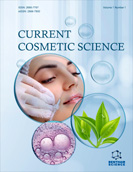
Full text loading...

Several studies have shown the benefits of magnetic treatment on the productivity of secondary metabolites, growth, and the state of microalgae cultures.
This study examined the antioxidant and antimicrobial activity of lipsticks made with phycoerythrin (PE) extracted from the cyanobacterium Nostoc sp. under the influence of different magnetic fields (30 mT and 60 mT).
After cyanobacterial culture under magnetic fields of 30 mT and 60 mT, the PE was extracted and lipsticks were formulated. The primary evaluation methods used in this study are melting point, breaking point, linoleic acid peroxidation assay, force of application, stability, surface abnormalities, skin irritation, thixotropy character, dispersibility test, perfume stability, colorimetric assay, antioxidant, and microbial analysis.
The 30 mT treatment showed the highest concentration, purity, dry weight, antioxidant activity, and percentage of PE extraction compared to control cultures. No significant differences were found in the melting point, stability, thixotropy character, dispersibility, or perfume stability tests. The breaking point and force of application decreased significantly during 30 days. Peroxidation assay tests revealed lipstick increased oxidation and antioxidant activity after 30 days of 30 and 60 mT treatments compared to non-PE cultures. The study found that the amount of ΔE increased significantly in cultures without PE over time, while this increase was lower in magnetic field-treated cultures. However, no signs of crystal formation, surface wrinkles, liquid secretion, itching, or skin irritation were observed in 30 days of 30 and 60 mT magnetic treatments compared to control cultures with PE. Microbial analyzes over 30 days showed a significantly lower number of bacteria under magnetic fields than control cultures. In addition, the results of counting Escherichia coli and coliform bacteria were negative for thirty days. The antioxidant activity of PE was significantly higher in magnetic field-treated cultures. The number of Staphylococcus aureus decreased significantly in all cultures under magnetic field influence.
The overall results of this study showed that magnetic fields had a significant effect in many evaluation tests on the culture of cyanobacteria Nostoc sp. As a result, lipsticks made with extracted PE have more antioxidant and antimicrobial activity.